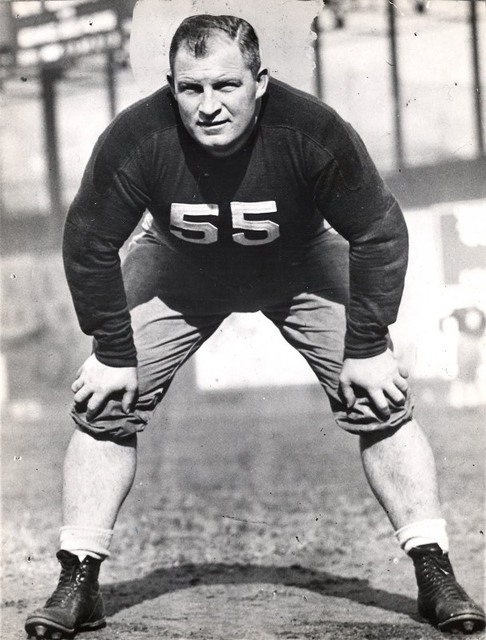Steve Owen: The Rock The New York Giants Were Built On
When Steve Owen, who coached the New York Giants from 1931 through 1953, died of a cerebral hemorrhage at his home in Oneida, New York, I debated for a day whether to make the trip south for the funeral. For a long time I had felt that I owed Owen such homage, and I’d never again be able to pay it… I had wanted to make the pilgrimage because it was Owen, as much as any other, who had brought me round to the Giants and made me a fan. Unable to conceive what my life would have been without football to cushion the knocks, I was sure I owed him sorrow. – Frederick Exley, A Fan’s Notes
Other than Wellington Mara, no other individual in the history of the New York Football Giants has had a bigger impact on the franchise than Stephen Joseph Owen. Yet sadly, Steve Owen is largely unknown and rarely remembered by fans.
Steve Owen was a four-time All-NFL, two-way tackle who played for the Giants from 1926 to 1931. Continuing as a player-coach, Owen became co-head coach with Benny Friedman for the final two games of the 1930 season. In 1931, he assumed sole head-coaching duties of the Giants for the next 23 years until 1953. In 1954 and 1966, Owen served as a scout with the Giants.
Thus for 30 years, during the crucial formative years of the franchise, Owen was the most pivotal figure within the organization not named Mara. As a player, he captained the 1927 team that won the team’s first NFL title and held opposing teams to a single-season, record-low total of 20 points. Then an entire generation of Giants’ fans grew up knowing no other head coach than Steve Owen. The first “golden age” of Giants’ football was not from 1956-63, but from 1933-46 when, during that 14-season time span under Owen, the Giants played in eight NFL Championship games, winning two.
“Steve Owen was really the rock that we built on,” said Wellington Mara. “He was like my second father…I admired him, was greatly attached to him, and respected him. He kind of brought me up in the football business.”
A Wrassler from the Indian Territory
Steve Owen was born on the same day – April 21, 1898 – that President William McKinley asked Congress to declare war on Spain. Owen was born in Cleo Springs in the Indian Territory (now Oklahoma), where his father had claimed land when the Cherokee Strip was opened to settlers. Owen’s father farmed the land while his mother became the area’s first schoolmarm.
Owen’s high school did not have a football team. “Outside of wrasslin’, we didn’t have any time for sports,” said Owen. “We were too busy with chores and schoolin’ and watchin’ the marshals chase outlaws across the Cimarron River.”
By the time he was 16, Owen already weighed 220 pounds. Apparently, his father was so proud of his strength that he would wake up Steve in the middle of the night to wrestle some stranger he had brought home. “I wasn’t allowed to go back to bed until I whipped the fellow Pop brought home,” said Owen.
In the summer as a high school teenager, Owen would travel to Texas to work the oil fields, making $3 a day for 12 hours of work. Owen wanted to return to Texas after graduating. However, Owen’s mom convinced him to attend Phillips University in Enid, Oklahoma where Owen enlisted in the Student Army Training Corps with America’s entry into the First World War. In college, Owen wrestled professionally under the alias “Jack O’Brien” in order to protect his amateur standing.
It was also at college where Owen was introduced to football. His college coach told him, “Son, you now have the secret. It’s a rough game and you’ll get hurt if you let the other fellow hit you harder than you hit him. That’s why football is a good game. It won’t let a man play easy. You’ll learn the rules fast enough. Just remember this: respect every other boy on this squad and work with him. Never lose respect for your opponent or he’ll hit you harder than you hit him.”
A Champion as a Giants Player
In 1924, Owen signed with the Kansas City Blues for $50 per game. He also played for the Cleveland Bulldogs and Kansas City Cowboys in 1925. The Giants were so impressed with Owen that they bought Owen from the Cowboys in 1926 for $500.
“I had seen a lot of fat hogs go for more than they paid for me,” said Owen, “but in those days a fat hog was a lot more valuable than a fat tackle. I was going to New York even if I had to walk there.”
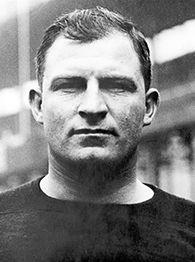
Steve Owen
Owen rapidly became one of the best players on the Giants. He played for the Giants from 1926-1931, plus a one-game return in 1933. ”Stout Steve” captained the 1927 Championship team that went 11-1-1. He anchored a defense that incredibly held opposing offenses to 20 points all season. The Giants shutout 10 teams that year and out-scored their opponents 197-20. Owen was named All-NFL four times during an era when tough men played 60 minutes on both offense and defense. Depending on the source, Owen ranged anywhere from 5’10’’ to 6’2’’ and 215 pounds to 260 pounds. (Most sources say 5’10” and around 245 pounds). “Stout Steve” Owen was known as a brutal tackler.
“If a boy isn’t willing to get off the ground and hit back a little harder than he was hit, no coach can help him,” said Owen.
“It was a one-platoon game then,” said Wellington Mara. “As Steve Owen used to say, men were men in those days.”
“Football was a different game then,” said Owen. “The ball was bigger and harder to pass, you couldn’t pass from closer than five yards behind the line of scrimmage, and, in 1927, they moved the goal posts back ten yards from the goal line. But the big difference was the way we played the game. We were pretty much a smash-and-shove gang. We were bone crushers, not fancy Dans.”
A Champion as a Giants Coach
Owen and QB Benny Friedman took over head coaching duties from LeRoy Andrews for the last two games of the 1930 season. In 1931, Owen became the Giants’ sole head coach, despite sometimes still putting on the uniform.
“Steve Owen was the Giants’ head coach when I joined the team in 1931,” said Hall of Fame Giants’ center/linebacker Mel Hein. “It was his first full year as head coach. Actually, Steve was player-coach that year, but he only suited up for about three games. He was about 33 or 34 then. Steve was a very good coach, though, and all the players respected him.”
As a head coach, Owen never signed a contract with the Mara family. At the end of each season, from 1931 to 1953, he coached on a simple handshake agreement.
“Life and football were similar to Owen,” said journalist and author Gerald Eskenazi. “Neither was complicated. Appearances were not deceiving. He judged a man by his actions, and it was as simple as that.”
Owen was the first NFL coach to emphasize defense, and thus, Owen really is the grandfather of the franchise’s defensive tradition. Upsetting fans, Owen would often go for the sure field goal rather than gamble on the touchdown. “Steve was the first to stress the importance of defense and the advantage of settling for field goals instead of touchdowns,” said the Chicago Bears’ legendary George Halas in 1953. “Every team strives today to do what Owen was doing twenty years ago.”
Owen believed in solid, physical, fundamental football. He made sure his players knew how to block and tackle. Owen was not splashy and his run-oriented offenses were criticized as being too conservative.
“If it’s new,” wrote a sportswriter, “Close-to-the-Vest Owen won’t try it.”
“Football is a game played down in the dirt and it always will be,” said Owen. “There’s no use getting fancy about it.”
The NFL did not start playing championship games until 1933. Owen’s first two seasons as head coach were underwhelming as New York finished 7-6-1 in 1931 (fifth in the NFL) and 4-6-2 in 1932 (fifth in the NFL).
Everything changed in 1933. The NFL inaugurated the divisional structure combined with the NFL Championship Game. Under Owen, the Giants became perennial contenders and would play in eight of NFL’s first 14 championship games.
In 1933 and 1934, the Giants finished first in the NFL’s new Eastern Division with 11-3 and 8-5 records, respectively. The Giants lost the 1933 Championship to the Chicago Bears in a nail biter 23-21. The following season, New York enacted their revenge on the undefeated 13-0 Chicago Bears by winning 30-13 in the famous “sneakers” 1934 Championship Game. The Giants won the Eastern Division again in 1935 with a 9-3 record, but lost the 1935 Championship Game to the Detroit Lions 26-7.
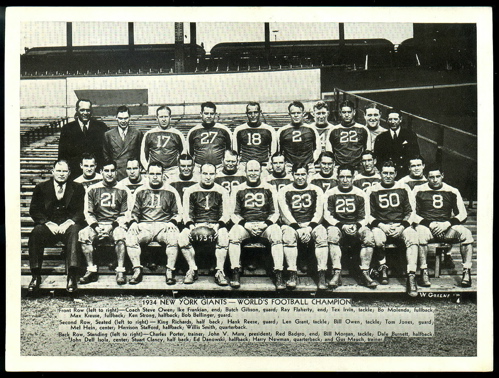
1934 New York Giants
After a two year hiatus from the playoffs, the Giants won Eastern Division in 1938 (8-2-1) and 1939 (9-1-1). The Giants beat the Packers 23-17 in a thrilling Championship Game in New York in 1938, but lost the 1939 Championship Game in Milwaukee to the Packers 27-0.
In the next seven seasons, the Giants would win the Eastern Division three more times and tie for the division lead in another season. But the Giants would lose all four post-season games, including the three Championship Games and the division tie-breaker. The Bears beat the Giants in the Championship Game in 1941 (39-7) and 1946 (24-14), and the Packers beat the Giants in the 1944 Championship Game (14-7). The Giants also lost the divisional tie-breaker 28-0 to the Redskins in 1943. From 1942-45, many of the Giants’ best players had gone off to fight the Germans and Japanese.
Appearing in eight NFL Championships in 14 years was a remarkable run. However, Owen’s luster began to fade after the 1946 season. The Giants fell to 2-8-2 in 1947, 4-8 in 1948, and 6-6 in 1949.
“I still didn’t know much about football,” said Giants’ owner Tim Mara, “but I knew from what my sons told me that what was happening to us wasn’t the coach’s fault. We just weren’t giving Owen the players to win, and that was our fault, not his.”
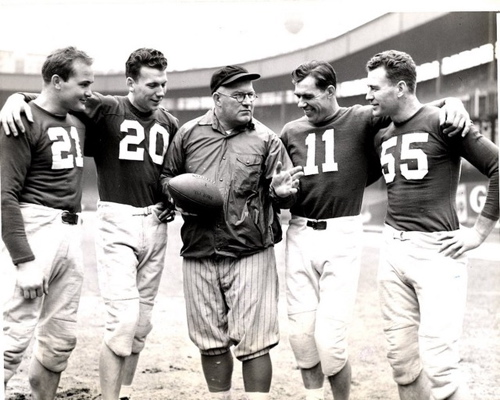
Steve Owen (Middle) at 1941 Pro Bowl
Despite the introduction of the powerhouse Cleveland Browns into the Giants’ division, Owen’s Giants rebounded in 1950 (10-2, first-place divisional tie), 1951 (9-2-1, second place), and 1952 (7-5, second place). Nevertheless, when the Giants fell to 3-9 in 1953, the writing was on the wall for Owen and the Giants. It had been seven years since the Giants played in a Championship Game and 15 years without a post-season victory. The game was entering the modern era, with more attention to detail and complex new offensive innovations. It was clear the NFL was changing but Owen wasn’t. It was time to go.
In the waning moments of his last game as head coach of the Giants – a 27-16 loss to the Detroit Lions in December 1953 – television cameras showed Owen standing alone on the sidelines in tears.
Officially, Owen “resigned” but he was forced to do so. Wellington Mara said the decision to let Owen go was extremely difficult. “It was like telling your father you’re putting him out of your home,” said Mara.
“You’ve got a place with the Giants as long as you live, Steve,” said Jack Mara to Owen. “I hope you know that.”
Owen served as a scout with the Giants briefly, but then he moved on. “He was hurt and wanted no part of that,” said Wellington Mara.
The Innovator
Owen was criticized for being unimaginative. But not only is he recognized as the first NFL head coach to focus on defense, Owen is credited with several important innovations.
In the old NFL, player substitution was restricted. If a player left the field, he couldn’t return until the next quarter. There were no separate offensive, defensive, and special teams units. Most teams played their 11 two-way starters until they dropped. By the fourth quarter, the best players were usually hurt or out of gas. In 1937, Owen was the first head coach to develop a two-platoon system by maintaining two relatively equal squads and substituting 10 starters at the end of the first and third quarters. (Because he was so valuable, center/linebacker Mel Hein continued to play a full 60 minutes).
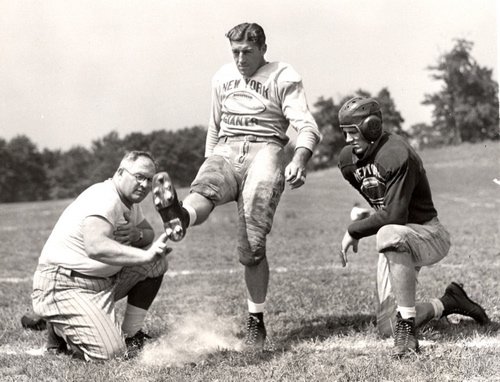
Steve Owen, Ken Strong, and Ward Cuff in 1939
“To start with, (the two-platoon system) lessens the wear and tear on the individual player,” said Owen. “He doesn’t play enough to get tired and therefore is better able to absorb the bumps that go with the play. But more important I think is the effect on team morale. I find that a rivalry has risen between my A and B squads. Each one wants to outdo the other and that’s incentive to keep ’em driving. So long as I can keep my two squads intact, I’m convinced the Giants will continue to win.”
Owen also devised the A-formation in 1937, which at the time was considered a radical offensive concept. After showing one offensive set, the Giants would then shift into the single wing, double wing, punt formation, or the A-formation. In the A-formation, the Giants would unbalance their line to one side and overbalance the backfield to the other side.
“He split his lineman and placed four on the right side of the center and just an end and tackle on the left,” said Giants’ fullback/safety Hank Soar. “He put the wingback behind the weak side end, the blocker behind the weak side tackle, the tailback four yards behind the center with the quarterback a yard in front of him and to his right.”
The A-formation was difficult to defend because the center could snap the football to one of three players – the quarterback, fullback, or blocking back. And either the quarterback or fullback could throw the football. The Giants were the only team to use the A-formation because it required having a great center, and the Giants were fortunate enough to have the best in the game, Mel Hein.
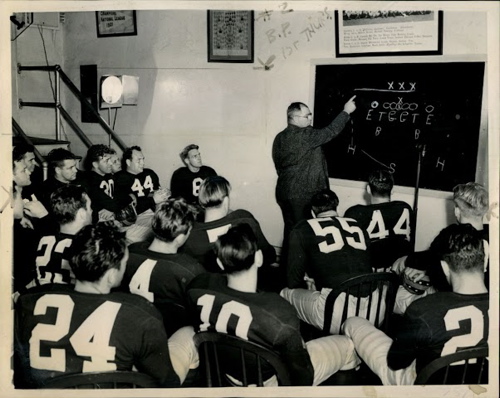
Steve Owen at the Blackboard in 1939
Owen was at heart a defensive coach and he was not afraid to innovate on defense. Teams traditionally used seven-man defensive lines, but Owen experimented with six- and five-man fronts. In 1937, he moved the Giants to a 5-3-3 defense.
“Even as a player Steve was conscious of the importance of a good defense,” said Soar. “He tried to convince his coach to use such radical departures from the standard defenses as five and six-man lines. When he became coach of the Giants he put his ideas into action. We had stunting linemen, rushing linebackers although we did not call it the blitz, and as the safety man I often performed what is now called the safety blitz. We had a very good pass defense and fellows like (Sammy) Baugh, (Cecil) Isbell, and (Don) Hutson seldom had good days against us.”
In 1950, Owen is also credited with creating the umbrella defense, which was largely designed to stop the dynamic passing attack of QB Otto Graham and the Cleveland Browns. The umbrella employed a 6-1-4 formation that would have the ends drop into coverage, placing the defensive emphasis on coverage rather than the pass rush. It was a novel concept at the time and it worked like a charm against the super-talented Browns for a few years. In fact, Owen’s Giants won four of their six regular-season meetings against the Browns from 1950-52. The 10-2 Giants were the only team to beat the Browns (twice) in 1950, including shutting Cleveland out for the first time ever, but New York lost the divisional playoff to the Cleveland 8-3. This was the start of the great Giants-Browns rivalry of the 1950’s as New York proved to be Cleveland’s greatest nemesis.
Tom Landry was a defensive back in Owen’s umbrella defense, along with Hall of Fame defensive back Emlen Tunnell. A few years later, as Giants’ defensive coordinator, Landry would tweak Owen’s umbrella defense, creating the modern 4-3 defense.
Owen Comes Home
After Owen “resigned,” he remained with the Giants briefly as a scout in 1954. He went on to do some coaching with South Carolina, Baylor, and the Eagles. Owen then served as head coach for the CFL’s Toronto Argonauts (1959), Calgary Stampeders (1960), and Saskatchewan Roughriders (1961-62). Owen was named CFL Coach of the Year in 1962.
Owen suffered a heart attack late in 1962 and he resigned from the Roughriders in January 1963. Unable to stay away from football, Owen became the head coach of the United Football League’s Syracuse Stormers in March 1963. But the Stormers finished the season winless at 0-12.
After coaching the Stormers, Owen came home. “Do you think you could find a job for a broken down old coach?” Owen asked Jack Mara. “I know we can,” said Mara. “We can always make room for another scout.”
Steve Owen died on May 17, 1964 at the age of 66 after suffering a terminal cerebral hemorrhage. He was survived by his second wife Miriam who passed away in 2001 at the age of 90. Both are buried in St. Patrick’s Cemetery in Oneida, New York. (Owen’s first wife Florence passed away in 1933 in Boston, during training camp).
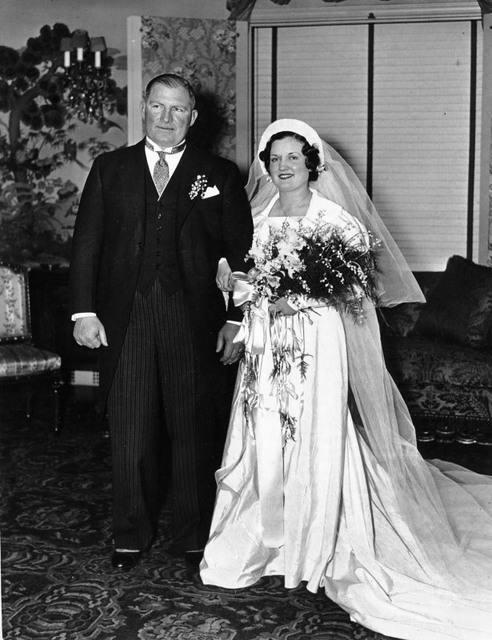
Steve Owen and Miriam Sweeney in 1935
At the time of his death, Arthur Daley of The New York Times wrote, “It was only fitting that stout Steve should have been a member of the Giant organization when he died yesterday…It is quite possible that no professional coach ever inspired more love, devotion, and admiration among his players than did Steve. The only counterpart was Knute Rockne at Notre Dame. A might stout fella was Owen. The Giants and all professional football owe him much for his contributions.”
Owen was inducted into the Pro Football Hall of Fame two years later in 1966. The Hall later named him to the “All-NFL Team of the 1920’s.”
As a player, Steve Owen anchored and captained the Giants’ 1927 Championship team. As head coach for nearly a quarter century, Owen’s Giants accrued a 153-100-17 regular-season record. No other Giants’ head coach comes close to matching Owen’s win total. His Giants won eight division titles and two NFL Championships. He began New York’s storied defensive tradition, and created the two-platoon system, the A-formation, and the umbrella defense.
As a Hall of Fame player and a coach, Steve Owen was a Giant among men.

